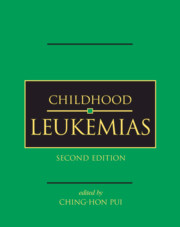Book contents
- Frontmatter
- Contents
- List of contributors
- Preface
- Part I History and general issues
- Part II Cell biology and pathobiology
- Part III Evaluation and treatment
- 14 Pharmacokinetic, pharmacodynamic, and pharmacogenetic considerations
- 15 Assays and molecular determinants of cellular drug resistance
- 16 Acute lymphoblastic leukemia
- 17 Relapsed acute lymphoblastic leukemia
- 18 B-cell acute lymphoblastic leukemia and Burkitt lymphoma
- 19 Acute myeloid leukemia
- 20 Relapsed acute myeloid leukemia
- 21 Myelodysplastic syndrome
- 22 Chronic myeloproliferative disorders
- 23 Hematopoietic stem cell transplantation
- 24 Acute leukemia in countries with limited resources
- 25 Antibody-targeted therapy
- 26 Adoptive cellular immunotherapy
- 27 Gene transfer: methods and applications
- 28 Minimal residual disease
- Part IV Complications and supportive care
- Index
- Plate Section between pages 400 and 401
- References
28 - Minimal residual disease
from Part III - Evaluation and treatment
Published online by Cambridge University Press: 01 July 2010
- Frontmatter
- Contents
- List of contributors
- Preface
- Part I History and general issues
- Part II Cell biology and pathobiology
- Part III Evaluation and treatment
- 14 Pharmacokinetic, pharmacodynamic, and pharmacogenetic considerations
- 15 Assays and molecular determinants of cellular drug resistance
- 16 Acute lymphoblastic leukemia
- 17 Relapsed acute lymphoblastic leukemia
- 18 B-cell acute lymphoblastic leukemia and Burkitt lymphoma
- 19 Acute myeloid leukemia
- 20 Relapsed acute myeloid leukemia
- 21 Myelodysplastic syndrome
- 22 Chronic myeloproliferative disorders
- 23 Hematopoietic stem cell transplantation
- 24 Acute leukemia in countries with limited resources
- 25 Antibody-targeted therapy
- 26 Adoptive cellular immunotherapy
- 27 Gene transfer: methods and applications
- 28 Minimal residual disease
- Part IV Complications and supportive care
- Index
- Plate Section between pages 400 and 401
- References
Summary
Introduction
A multitude of clinical and biologic factors have been associated with a variable response to treatment in patients with acute leukemia, but their predictive power is far from absolute, and their usefulness for guiding clinical decisions in individual patients is inherently limited. Rather than predicting treatment response, in vivo measurements of leukemia cytoreduction provide direct information on the effectiveness of treatment in each patient. This information should have great clinical utility, but estimates by conventional morphologic techniques have a relatively low sensitivity and accuracy: in most cases, leukemic cells can be detected in bone marrow with certainty only when they constitute 5% or more of the total cell population. These limitations are overcome by methods for detecting minimal (i.e. submicroscopic) residual disease (MRD), which can be 100 times more sensitive than morphology and allow a more objective assessement of treatment response. The definition of “remission” in patients with acute leukemia by these methods is becoming the standard at many cancer centers.
Initial reservations regarding the clinical utility of MRD testing arose from concerns regarding the heterogeneous distribution of leukemia during clinical remission. Another concern was that MRD signals may not correspond to viable leukemic cells with the capacity for renewal. As discussed in this chapter, several correlative studies of MRD and treatment outcome have now firmly established that MRD studies can be highly informative.
The first MRD studies in patients with leukemia were made soon after antibodies for leukocyte differentiation antigens became available.
- Type
- Chapter
- Information
- Childhood Leukemias , pp. 679 - 706Publisher: Cambridge University PressPrint publication year: 2006
References
- 1
- Cited by



